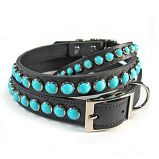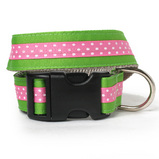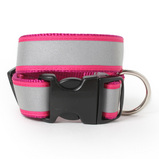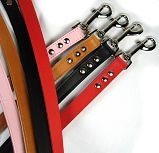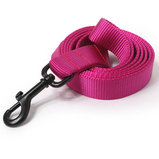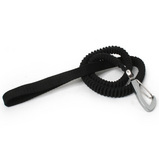Leash training your puppy is a very important part of your new responsibilities, but it can quickly develop into a battle of wills if you don’t approach it the right way.
In This Article You Will Read About
Your Rottweiler puppy is going to be a big, strong dog before you know it, and leash training is best done while he’s still ‘puppy-sized’!
Although it’s perfectly possible to leash train a dog who’s adolescent or adult, but it takes a lot more strength, energy and patience…. so save yourself the aching arm and start now.
Puppy Leash Training – The Basics
Before you even begin leash training a puppy, you need to get the little guy or gal used to wearing a collar - and then a collar and leash.
A nylon collar is the best choice for very young puppies, but as Rottweilers are fairly sturdy pups, a fairly narrow and soft leather collar is also an option.
Start out by having your pup wear her collar for 15 – 30 minute stretches.
If her breeder didn’t acclimate her to the feel of a wearing a collar, she may well act as though you just wrapped a python around her little neck!
Scratching at it, pawing at it, trying to ‘rub it off’ by rolling around on the carpet – they’re all perfectly normal reactions.
She may even try to run away from the collar (difficult as it’s actually attached to her), or sit stock still hoping it will magically disappear.
Your best reaction to her behavior is no reaction! You can try to distract her with a toy or a game, but don’t touch or bring attention to the collar in any way.
Ignore her complaints, and don’t take it off her until she’s forgotten about it and isn’t fussing about it anymore.
Here are some beautiful collars to choose from….
After a few days, you’ll be ready for the next step – that’s actually using the leash!
But, don’t get too excited….. you still need to take it slowly, and for now all you want to do is attach a light leash to your puppys’ collar and let her get used to feeling the weight of it.
In fact, you’re not even going to hold the leash just yet.
To begin with all you’re going to do is to simply clip it onto her collar and let her drag it around the house for 10 mins or so at a time.
Of course, you need to follow supervise her the WHOLE time she’s doing this, as if it gets caught on something, or she gets tangled up in it she could be frightened, or even hurt.
Choose A Light Leash
For this part of the process, a light leash is best.
A leather one is more likely to be chewed and played with, and a chain is just too heavy and could be dangerous.
A lightweight (and cheap) nylon leash would be your best bet for now.
After a few days of running around with the leash dragging behind her, your puppy is now ready for you to join in the game.
So, at your next leash training session, pick up the end of the leash and start to follow where she leads.
She’ll probably really enjoy this part!
This is also a good time to take a step up and you, puppy and leash can venture out into the back yard.
Your puppy needs to feel totally comfortable with all of this before you move on.
How To Leash Train Your Puppy
Now that your puppy is familiar with the collar and leash, you can start to actually walk together.
Of course, this is going to be a novel idea for your little girl, and you’re going to need to be very patient, take it slowly, and be very consistent in your efforts.
Leash training while your pup is young has one very important benefit here – the fact that little puppies have an innate desire to follow their owners!
Your pup will probably want to be right beside you and will be more willing to stay by your side now, than when she’s a bit older… and bolder.
Again, start indoors where she feels comfortable, and gently lead her around.
Encourage her with a happy, up-beat voice, and a treat whenever necessary.
Your aim is to have her follow you happily, not being dragged or forced, that will soon put a dent in your leash training progress.
When (and it is ’when’ not ‘if’) she decides that she wants to ‘take the reins’ and pulls forward, or to the left or right, you need to stop moving immediately.
Then call her to you in a cheerful voice and praise her when she comes close to you.
Once she’s back by your side, say something along the lines of “Let’s go!” and move forward again.
Leash training puppies relies on a lot of repetition, and you will need to practice this over and over again.
But remember, these little ones have short attention spans and your training ‘lessons’ should be short, but frequent.
Your aim here is to have your little girl realize that if she pulls hard, or away from you, that the walk stops and so does the fun. Once she ‘gets it’ she will happily follow you.
Some puppies may try to rebel by sitting (or lying) down and refusing to move an inch.
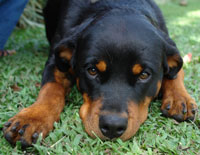
The temptation to tug or drag them may be strong, but you need to resist!
Instead, do as you did for the wandering pup, call her to you (encourage her by crouching down, offering her a treat and so on if necessary) and reward her when she gets there.
Then say “Let’s go” and move on.
If you’re leash training a puppy outside, you can often get a really stubborn puppy moving by backing up a few steps and then ‘jogging’ past them (still holding the leash of course!) while calling their name.
Your puppy won’t be able to resist running after you – works like a charm.
The Best Collars & Leashes For Training A Puppy
Once you’ve mastered the very basics of leash training a puppy, you will want to graduate from the basic nylon collar and leash.
Rottie pups are robust and strong, and you’ll want a collar and leash that can handle the pressure!
A soft leather collar with a proper buckle (not a plastic snap) is the best choice, and a leather training leash will be a very good investment.
There are all sorts of styles and lengths of dog training leashes, for proper training sessions I prefer leather leashes because they last forever and only get better with age.
Nylon or lightweight leashes are good for puppies, and are less expensive, but also not as durable.
I’d strongly suggest that you stay away from retractable leashes, I believe they’re unsafe for both puppy/dog AND owner. They can cause injury and accidents.
A short ‘traffic leash’ is a fantastic training tool, and I think every owner of a medium to large-sized breed should have one.
Your pup or dog can wear one whenever you’re home or with her, and it’s easy for you to correct her behavior with a quick tug on the leash, or get hold of her quickly if you need to.
Smaller breeds need lighter, thinner collars and light-weight leashes, there are tons of these to choose from as well.
Here are some excellent collars and leashes for you to take a look at….
Leash training your puppy properly doesn’t just set the stage for enjoyable walks together, but it also lays the groundwork for formal obedience training… and tracking, agility, Shutzhund and more.
It doesn’t need to be a struggle… just follow the tips above, be patient and consistent, and you will be successful!
Related Pages….
- Puppy Training Tips
- Your Rottweiler Puppy
- German Dog Commands
- Dog Training Tools
- The Very Best Big Dog Collars

